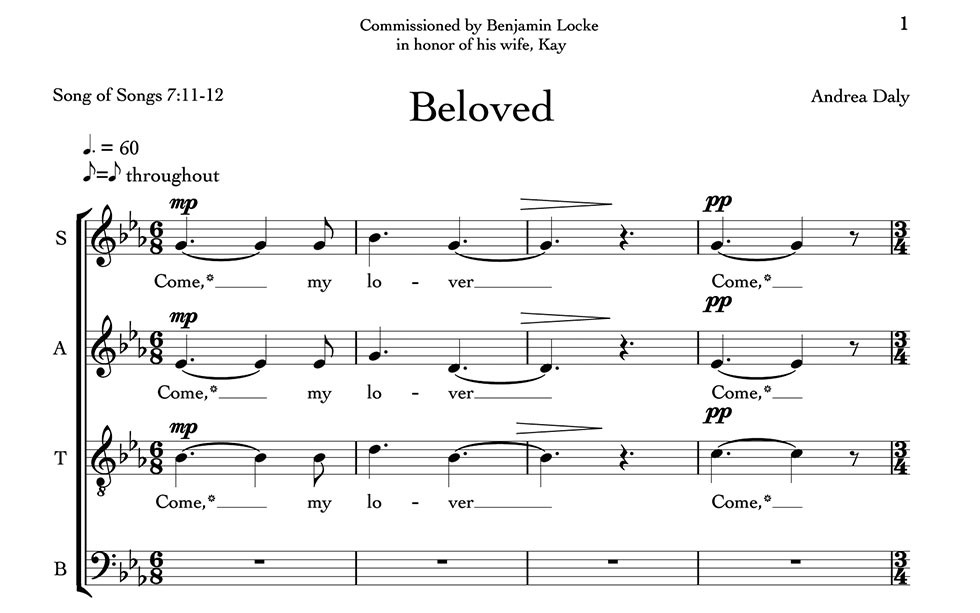Is the American Experiment Still Viable?
Your guide to the United States in 2021 and beyond.
Read The StoryComposer Andrea Daly '06 shares the inspiration and process behind the song "Beloved."

Andrea Daly ’06 is a New York-based composer and songwriter who creates everything from pop songs to theatrical work to classical scores. The following score was commissioned by Professor of Music Benjamin Locke in 2019, to honor his wife, Kay Locke, and as part of a larger celebration of 50 Years of Women at Kenyon. “I was grateful to be able to attend a rehearsal on Valentine’s Day that Kay also attended, where we both heard it for the first time,” Daly said. “The choir nailed the music, and many of us were choked up. When Kay passed away unexpectedly a few months later, the personal aspects of the score became still more meaningful through our collective loss.” In March, the Chamber Singers created a virtual recording of the piece (viewable on YouTube). “They shared it with the world only six days before Kay left us,” Daly added.
Learn more about Daly at andreadalymusic.com.
On choosing the text: The commission required a spiritual text, so I found a passage in “The Song of Songs” where the Lover invites his Beloved to run away to the countryside. The bucolic references reminded me of Kenyon. Since Professor Locke asked me to write the piece in honor of his wife, Kay, the title naturally became “Beloved.”
On composing the music: I love what happens when language dissolves into musical sounds. The asterisk at the end of the word “Come” instructs the choir to close to an “mm” sound, so the word itself becomes a hum. This opening phrase, “Come, my lover,” is the main recurring motif throughout the piece. Even when the piece feels harmonically unstable, you can still hear the motif rising and falling in thirds.
Tolling bells: When I was in Chamber Singers, we sang a work by Sergei Rachmaninoff called “Shestopsalmiye [The Six Psalms],” in which some vocal parts were written to sound like bells. The second section of “Beloved” is a tribute to that idea. I ask the basses to sustain bell-like tones, while the upper parts decorate with running lines. The changing meter and off-beat accents make the beat unpredictable, also like tolling bells. This is additionally a reference to the regular bells I always heard coming from Harcourt Parish on campus.
On tonal shifts: Although much of the music in “Beloved” is pretty energetic, the ending of the Scripture passage feels very intimate; I wanted to set up that shift with both a dynamic and harmonic musical shift in the score. Drawing on Chamber Singers memories again (this time from singing Samuel Barber’s “The Coolin”), I ask the choir to transition at the double bar line from a climactic harmony to a softer, unexpected one. Normally the effect would be jarring, but in this case there is one note the same in both chords, which makes the transition feel more like a relaxation or turning inward.
On perfect pitch: “Beloved” ends with the same chord on which it began, except that here at the end the sound is more complete. This E-flat chord holds special significance for Chamber Singers, because it is the one Locke uses regularly to test our “perfect pitch” [our ability to produce specific notes without any cues]. In that way, the existence of music might be compared to love itself: arriving from nothing to grow into something, and remaining there always, even when the cues cease to exist.
Your guide to the United States in 2021 and beyond.
Read The StoryOB-GYN and public health scholar Karen A. Scott ’98 is leading a new research project — the first of its kind…
Read The StoryWhen her senior drama thesis performance was canceled due to COVID-19, Talia Light Rake '20 turned Zoom into art…
Read The Story